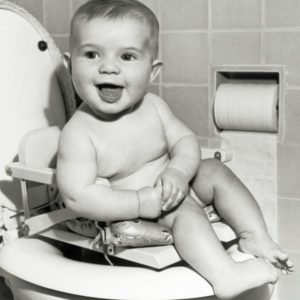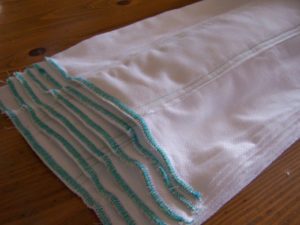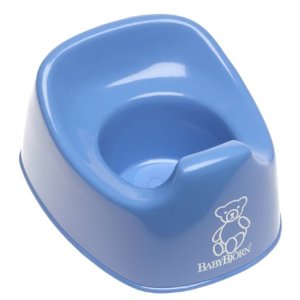Q: I had my baby last month and I’m really curious about elimination communication. I’ve read about it and I’m totally intrigued but skeptical! Can it really be done? I feel like my baby poops all the time, can I really teach my newborn how to potty train this early in the game? I’d love your take on it and some pointers. It would be pretty amazing not to deal with diapers all the time!
A: It’s possible to communicate with your baby, even during infancy, about their need to eliminate. You can take care of that need without using diapers. The modern name for this practice is Elimination Communication (EC), and it’s also known as Natural Infant Hygiene (NIH) and infant potty training. While it seems like a pretty wild idea to most people, it’s actually a very old way of doing things. Diaper-free babies are still commonplace in many parts of the world. We’re going to break down the basic steps to using this practice, and suggest a few simple things that can make it easier, plus share some great guides that can help you on your way.
Elimination Communication (EC) isn’t a strict protocol or an all-or-nothing approach to taking care of your baby’s toilet needs. Many parents go diaper-free all the way, while others leave the diapers off during the day and put them on at night, and others leave diapers on and take them off when it’s time to put their baby on the potty.
baby’s toilet needs. Many parents go diaper-free all the way, while others leave the diapers off during the day and put them on at night, and others leave diapers on and take them off when it’s time to put their baby on the potty.
If you are curious to try EC but feel afraid of getting pee or poop on your couch, don’t worry! The concepts and steps outlined below can be adapted to fit each baby and family’s needs and comfort. The benefits include saving hundreds (or thousands) of dollars on diapering, keeping your baby drier and free of diaper rash, tuning in and connecting with your baby’s needs, avoiding the need to potty train a headstrong toddler, and having a less hands-on relationship with your baby’s waste.
The basic premises of EC are these: babies have the body awareness to know when they need to eliminate and they can non-verbally communicate this need; predictable rhythms exist in babies’ elimination patterns; parents can tune in and work with their babies to keep them clean, dry, and to provide an appropriate place to relieve themselves when needed.
So, how do you connect those dots?
Non-verbal communication: All babies, especially very young babies, can use non-verbal communication to express their bodily needs. We are all used to the idea that a baby may cry or fuss if they are tired or hungry, and the need to eliminate is no different. If you shift your mindset to believe that your baby notices the sensation of a full bladder or bowels, then you can begin to notice their non-verbal communication around these needs.
Cueing: EC is a little like training an animal: signals and repetition are crucial. Starting out with a cueing sound and position, and using that combo every time your baby eliminates, helps them to associate that cue with their body process. Most parents use a soft ssss sound for pee and a low grunt (similar to the noise most babies make when they defecate) for poop. Holding your baby by the upper thighs in a supported squat position, resting against your belly or chest is the most common position cue.
Timing: For the first few months, babies eliminate very frequently, then it slows down a bit as they grow. At every stage you can observe and notice patterns, and learn to respond accordingly. Most babies’ elimination rhythm is related in some way to feeding and sleeping rhythms, all of which, as a parent, you will be tuning in to and finding patterns in.
Intuition: After some time observing and working with your baby to tune in to their elimination signals and timing, your intuition will just tell you “they need to go.” In the same way that parents often have a feeling about a kid getting sick or going through a developmental leap, intuition and connection with your baby can play a big role in EC.
Resources
These steps are a very basic overview, meant to give you a better idea of how in the heck you might be able to potty train an infant. There are lots of amazing resources out there to help you along your way if you choose to try EC with your baby. One of our favorites is a book by a fellow Asheville resident, Andrea Olson. It’s called Go Diaper Free: A Simple Handbook for Elimination Communication, and on her website (www.godiaperfree.com) she offers a message board/support group for people who have purchased the book. For those who like using social media, this format can be an awesome way to connect with other parents going through the same process and get support and guidance. Andrea also shares videos, blog posts, online classes, guides for toddler potty training, suggested other resources, and even sells a board book about potty training for toddlers.
Another good book is Diaper Free: The Gentle Wisdom of Natural Infant Hygiene by Ingrid Bauer. This is more of a stand-alone book and doesn’t have an ample, interactive website to go along with it. It covers a lot about the history and use of EC around the world, and offers many personal accounts of parents who have used this practice. It’s more geared toward completely diaper-free babies and not as much to hybrid diaper/EC use. If you are more the kind of person who likes to dive into a book and run with it in your own way than someone who enjoys using interactive websites and media to learn, this might be your best choice.
While EC doesn’t require any special equipment or gear, there are a few things that can be really helpful during the process. Following is a list of those things you might want to buy, including homemade or thrift-store hacks that can replace almost all of them.
Supplies
Prefold cloth diapers are super helpful. When your bab y is tiny, you can hold a prefold underneath their bottom to catch what comes as you are both learning their rhythms and getting to know the cues. As they get older, prefolds are great for cleaning up puddles and messes that may happen from time to time. An old towel or flannel sheet also work, but prefolds are super absorbent, are made to withstand many washings, and are already hemmed in a convenient size. Often used prefolds are available at consignment baby shops, but even new they are pretty affordable.
y is tiny, you can hold a prefold underneath their bottom to catch what comes as you are both learning their rhythms and getting to know the cues. As they get older, prefolds are great for cleaning up puddles and messes that may happen from time to time. An old towel or flannel sheet also work, but prefolds are super absorbent, are made to withstand many washings, and are already hemmed in a convenient size. Often used prefolds are available at consignment baby shops, but even new they are pretty affordable.
A tiny potty of some kind is crucial for an EC baby. Some folks use a plastic mixing bowl or large tupperware container instead of an actual potty at first. Many kid-sized potties are big and cumbersome, but Baby Bjorn makes a small one that is portable and approachable even for a little baby. The inner bowl part of the potty can be easily removed for washing, and is also great to hold in your lap when you are practicing EC with an infant who cannot yet sit up by themselves. An advantage of the Baby Bjorn potty (rather than a bowl), especially for boys, is that it has a backsplash. Another is that as soon as your baby can sit up on their own, the potty is stable enough to support them.
big and cumbersome, but Baby Bjorn makes a small one that is portable and approachable even for a little baby. The inner bowl part of the potty can be easily removed for washing, and is also great to hold in your lap when you are practicing EC with an infant who cannot yet sit up by themselves. An advantage of the Baby Bjorn potty (rather than a bowl), especially for boys, is that it has a backsplash. Another is that as soon as your baby can sit up on their own, the potty is stable enough to support them.
For diaper-free sleeping, it’s helpful to have some kind of mattress protector. An all-natural choice is a wool “puddle pad,” like the ones made by Holy Lamb Organics. These thick wool pads are placed under a fitted sheet and block moisture from going all the way through to the mattress. Wool is naturally anti-odor, water repellent, and resistant to fungus and bacteria. Layering a towel or some prefolds under your baby if they are sleeping without a diaper can help absorb any liquid that is blocked by the pad. Often you can find 100% wool blankets at thrift stores (usually with a few moth holes), and these can be used as puddle pads too. Wash any used blanket in hot water and soap to shrink and felt the wool before using it. This will make it much more impervious to moisture. Washing like this will also tell you whether the blanket is in fact made of wool, if it has lost its tag and you aren’t sure. Spun poly fiber blankets do not work well as puddle pads.
Most baby clothes are made to accommodate the bulk of diapers, and can be really baggy on diaper-free babies. You may find that a diaper-free baby wears slightly smaller pants than a diapered baby. Onesies and full-body suits are impractical for babies who don’t wear diapers, as EC requires frequent removal of the bottoms to let the baby use the potty. Just a simple combo of pants and a top usually works best. Snuggly merino wool leg warmers are a great way to keep babies warm while having easy access so that their elimination needs can be addressed super fast. Homemade leg warmers are easy to make out of sleeves from sweaters, simply cut to your desired length and sew to fit tight enough to stay up. Cashmere and merino wool sweaters (not scratchy) can be found at most used clothing stores.
Without a diaper, you may want your baby to wear underwear. Luckily Andrea Olsen (the author of Go Diaper Free, listed above), has a company called “Tiny Undies.” She makes both underwear and training pants for babies up to toddlers. Even if you aren’t doing EC, these 100% cotton, non-gendered, sweatshop-free, non-toxic underwear are a great choice as soon as your little one needs them.
If what works best for you is to keep diapers on your baby, or to use diapers sometimes, and take them off to use the potty, it’s helpful to choose a type of diaper that is easy to take off and put on. Using prefolds with clips and covers isn’t the best choice, as the whole changing process is multi-step and there are several loose items to keep track of. We love gdiapers for EC (and for babies who wear diapers all the time). They are essentially cloth outers with the option of reusable or disposable inners (prefolds fit into them too). They use velcro instead of snaps to close, making the whole process of changing a lot faster and simpler. A bonus is that the disposable inserts are 100% biodegradable and compostable. AlvaBaby is another good option. These diaper covers have a pocket that can be filled with a reusable insert, a prefold, or they can be used with GroVia’s disposable inserts. Disposable diapers also work with EC babies at night, on the go, or whenever you are wanting to use one. Since most babies practicing EC don’t soil a diaper every time it’s put on, it can actually be easier to use one of the options above instead of trying to reuse a disposable diaper several times.
Practicing EC, like all things parenting, is a unique journey for every family. Whether you choose to go 100% diaper free, or simply approach potty training sooner than the national average by integrating the biological principles that EC is based on, you and your baby will have your own way of doing things. Our hope is that some of these resources will help you along the way, and that your family finds exactly what works best for you.
Do you have a burning question that you haven’t had a chance to ask a care provider or are maybe too embarrassed to ask? We’ve got your back! The 411 is like a “dear doula” column where you get to (anonymously) ask about all those things you think you’re alone in wondering, or that you might be struggling with. We’re here to affirm that no, you are not alone. With evidence-based answers from not only birth doulas, but childbirth educators, experienced moms, lactation educators and more, we’ll help save you from falling down the Google rabbit hole. We wanna know what’s on your mind! Submit your question online.


